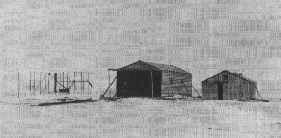On November 28, while giving the motor a run indoors, we thought we again saw something wrong with one of the propeller shafts. On stopping the motor, we discovered that one of the tubular shafts had cracked! Immediate preparation was made for returning to Dayton to build another set of shafts. We decided to abandon the use of tubes, as they did not afford enough spring to take up the shocks of premature or missed explosions of the motor. Solid tool-steel shafts of smaller diameter than the tubes previously used were decided upon. These would allow a certain amount of spring. The tubular shafts were many times stronger than would have been necessary to transmit the power of our motor if the strains upon them had been uniform.
But the large hollow shafts had no spring in them to absorb the unequal strains. Wilbur remained in camp while I went to get the new shafts. I did not get back to camp again till Friday, the 11th of December. Saturday afternoon the machine was again ready for trial, but the wind was so light, a start could not have been made from level ground with the run of only sixty feet permitted by our monorail track. Nor was there enough time before day to take the machine to one of the hills, where, by placing the track on a steep incline, sufficient speed could be secured for starting in calm air.

The 1903 machine and camp buildings. November 1903.